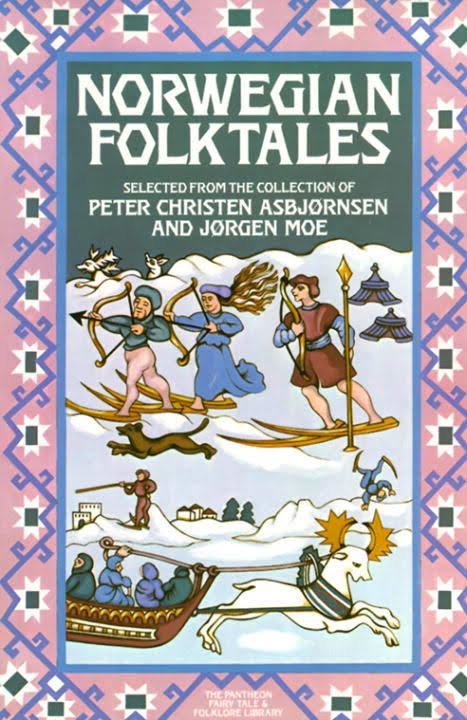8.2 /10 1 Votes8.2
Originally published 1841 | 4.1/5 Goodreads Genre Fairy tale | |||||||||||||||||||||||||||||||||
 | ||||||||||||||||||||||||||||||||||
Similar Peter Christen Asbjørnsen books, Fairy tale books, Other books | ||||||||||||||||||||||||||||||||||
Norwegian folktales
Norwegian Folktales (Norwegian: Norske Folkeeventyr) is a collection of Norwegian folktales and legends by Peter Christen Asbjørnsen and Jørgen Moe. It is also known as Asbjørnsen and Moe, after the collectors.
Contents
- Norwegian folktales
- Asbjrnsen and Moe
- Publications
- Illustrators
- Translation into English
- Norske Folkeeventyr
- Norske Huldre Eventyr
- Other pieces
- References
Asbjørnsen and Moe
Asbjørnsen, a teacher, and Moe, a minister, had been friends for about 15 years when in 1841 they published the first volume of folktales – the collection of which had been an interest of both for some years. The work's popularity is partly attributable to Norway's newly won partial independence, and the wave of nationalism that swept the country in the 19th century; and the Norwegian written language they contributed to developing (i.e., what would become Bokmål); their language style struck a balance: it was a national language distinct from the Danish of their overlords, but less Norwegian than the rural dialect in pure form.
Asbjørnsen and Moe were inspired by the German folktale collectors, the Brothers Grimm, not merely to emulate their methodology, but drawing encouragement by it, their endeavor was a work of national importance, especially as the Grimms openly gave high praise for the Norske folkeeventyr. Asbjørnsen and Moe applied the principles espoused by the Grimms, for instance, using a simple linguistic style in place of dialects, while maintaining the original form of the stories. Moreover, Asbjørnsen and Moe did not publish collected folktales in the raw, but created "retold" versions, seeking to reconstruct the lost Urform of the tales—although the alterations performed were not as drastic as the Grimms sometimes allowed license for themselves. The Norwegian pair also collected tales from the field themselves, in contrast to the Grimms.
Publications
The original series, entitled Norske Folkeeventyr went into publication piecemeal. It first appeared a slim pamphlet (1841) offering a selection of a few tales, without a title page, the editor's names or table of contents. This was sufficiently well-received, and championed by P. A. Munch in a German newspaper. It led to the appearance of a reprint of the first volume in 1843 and the second volume in 1844 as proper hardcovers. The second edition appeared in 1852. Another series dubbed the "New Collection" appeared later (Norske Folke-Eventyr. Ny Samling 1871). The tales are numbered, the original collection containing 58 tales, increased to 60 tales in later editions. The new collection held 50 tales.
Asbjørnsen as a solo project collected and published Norske Huldre-Eventyr og Folkesagn I-II (1845–48), which also was expanded by a "second collection,"(Norske huldre-eventyr og folkesagn: anden samling 1866).
Illustrators
The first fully illustrated of these book was the 1879 edition of Asbjørnsen's Norske folke- og huldre-eventyr, which featured the artwork of a battery of artists: Peter Nicolai Arbo (1831−1892), Hans Gude (1825−1903), Vincent Stoltenberg Lerche, Eilif Peterssen (1852−1928), August Schneider (1842−1873), Otto Sinding (1842−1909), Adolph Tidemand (1814−1876), and Erik Werenskiold (1855−1938)
In later editions Werenskiold and Theodor Kittelsen became prominent illustrators.
Translation into English
The tales were first translated into English by Sir George Webbe Dasent. He translated all but a few of the tales from the two series of Norske Folkeeventyr. Dasent's Popular Tales from the Norse (1859), contains all 58 tales from the initial edition of the original collection. Dasent's Tales from the Fjeld: A Second Series of Popular Tales (1874) covers the two tales from the original collection and 45 of the tales from the new collection.
Asbjørnsen and Moe evidently approved of Dasent's translations: "In France and England collections have appeared in which our tales have not only been correctly and faultlessly translated, but even rendered with exemplary truth and care nay, with thorough mastery. The English translation, by George Webbe Dasent, is the best and happiest rendering of our tales that has appeared."
H. L. Braekstad, Round the Yule Log: Norwegian Folk and Fairy Tales (1881) includes tales from the Norske Huldre-Eventyr. An abridged translation of Stroebe's Nordische Volksmärchen (1922), rendered into English by Martens, provides additional tales from the various collections, and complements the above translations to some extent. Pat Shaw Iversen and Carl Norman's Norwegian Folktales (1960) is a selection that includes some of the tales from the Ny Samling omitted by Dasent.
Norske Folkeeventyr
Legend:
Norske Huldre-Eventyr
Legend:
Other pieces
Tales not from any of the proceeding series that are usually included alongside them in later collections:
